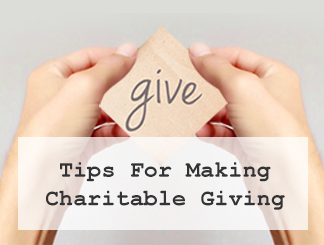Do you ever wonder if your charitable giving is having much of an impact?
As small business owners, especially those who may be struggling just to make ends meet, the ability to donate to charities may seem out of reach or it may seem that our contributions are so small they don’t matter much. But that is far from the truth!
How Small Business Giving Impacts Charities
A recent study by SCORE found that charitable contributions from small businesses have a tremendous impact on local communities because small businesses donate 250% more to local nonprofits and community causes than larger businesses do. In fact, a majority of small businesses give an average of 6% of their profits to charities each year. Whether you can contribute a little or a lot, what’s clear is that supporting charities is good for your business.
Why Charitable Giving Is Important to Small Businesses
Customers Care About Charitable Giving
Consumers are more intentional about the impact of their spending and want to support businesses and causes that they believe in. As a result, they want to know how businesses are supporting charitable causes. Consumers also have a more positive image of businesses that support a cause they care about. In fact, 91% will switch to a brand that supports a good cause and they are more likely to recommend businesses that do. (Source: Nationwide, 2017)
Charitable Giving Impacts Your Team
Charitable giving has been found to boost employee engagement and morale, improve employee well-being, and build unity among teams.
Want to have a happier team? Consider implementing a volunteer program. Why? Because 93% of employees who volunteer report being happy with their employer. (Source: SCORE, 2019)
Supporting Charities Helps Grow Your Business
Charitable giving can help grow your business because businesses that support charities receive:
- More word of mouth advertising from members of the charities they support, others who support the same charities, individuals who benefit from the support and services that the charities provide, friends and family members of individuals who benefit from the charity’s support and services, and customers who recommend businesses that support causes they care about
- Increased visibility as others become aware of your business, products, services, and social responsibility through the charities that you support
- Great networking opportunities with others who also support the charity, which makes networking so much easier and effective because you already share at least one obvious point in common
And this can result in a 10% – 35% increase in growth for your business because of your charitable giving, particularly if you make a donation each time a customer purchases from you. This gives consumers an incentive to do business with you.
Charitable giving may also be tax deductible for some businesses. For your convenience, here are links to two articles from the IRS about charitable contributions:
Charitable Contributions
Final Regulations On Charitable Contributions and State and Local Tax Credits
The rules about charitable contributions for businesses can be tricky. It is always best to consult with a qualified tax advisor to receive guidance about your specific circumstances.
Tips For Making Charitable Giving Work For You
 Make it part of the way you do business so charitable giving is effortless
Make it part of the way you do business so charitable giving is effortless
We all know that the easier something is to do, the more likely we are to do it. That’s why routines and habits are so effective. They remove the need for thinking and planning and allow us to accomplish things quickly, easily, and efficiently.
How can you make charitable giving effortless?
Allocate a specific dollar amount or percent of each sale that will be set aside for the charity of choice
An action that is repeated frequently is more likely to become a routine or habit. And routines or habits, once created, are easy to stick to.
Also, you feel less of an impact when you set aside $1 each time you make a sale rather than waiting until you have 100 sales and have to come up with $100 for charitable contributions.
Create and stick to an annual schedule for charitable events
There are endless opportunities to participate in charitable events such as collection drives (for canned goods, toys, coats, socks, scarves, hats, gloves, toiletries, and blankets) and fundraisers (like walks, runs, auctions, and sales), but most require planning and preparation. Selecting the events you will participate in each year and scheduling them ahead of time
ensures you won’t be caught in a last-minute scramble.
Select charitable causes that align with what your customers are purchasing
Studies show that customers are more likely to donate when the item they are purchasing fits the cause that their donation will be supporting. For example, someone purchasing pet products would be more likely to donate to a cause that supports animals like the local No Kill Shelter or Guide Dogs of America.
Be sure to include local causes
Consumers want to see the impact of their charitable contributions so it’s important to include charities that operate within the communities you serve. This ensures you and your customers will be able to see the results of your combined giving and make it more likely these charitable contributions will continue.
Do your research before choosing the charities you’ll support
When supporting a charity, you want as much of your donation to reach the intended recipients as possible. You also want to ensure you are donating to a bona fide charity and not being scammed out of your hard-earned money. The good news is that this information is readily available online.
- Here are the things you should know BEFORE making a charitable donation.
Make sure the charity is registered as a tax-exempt organization by the IRS - Review information the charity provides for potential donors. Check out the charity’s
website, its brochures, and financial statements. - Review third party assessments of the charity’s performance. The following
organizations are trusted sources of information about charities.
American Institute of Philanthropy
Better Business Bureau’s Wise Giving Alliance
Certified Charitable Giving Alliance
Charity Navigator
CharityWatch
GuideStar
Remember that the charities you support will reflect
Supporting a charity is like giving your recommendation. It says that you believe that the charity is reputable, trustworthy, and someone you choose to do business with. Therefore, the charity’s performance will have an impact on your reputation.
That’s why it is a good idea to ensure that the charity’s mission and the work they do aligns with you and your business. For example, if you are an eco-friendly business, you wouldn’t want to support a charity that has a reputation of doing things that are bad for the environment.
It is also important to be certain that the charity is reputable and has sufficient funds to remain in business. It’s not only the small, obscure charities you need to be concerned about here. Big charities that are recognized do not necessarily have a good reputation or manage money well.
Reputable charities will have evidence of the work they do such as photographs, testimonials, and awards. You should be able to find these on the charity’s website and in their brochures.
And, as mentioned before, you want to know that the majority of charitable donations received actually reach the intended recipients rather than being spent on the charity’s infrastructure and assets.
Lessons We Learned From Our Charitable Giving
 Up until this year (2019), we didn’t have a strategic procedure for our charitable giving. We did as most people do… selected popular charities that seemed to support the causes that were important to us and hoped that our contributions had the desired impact.
Up until this year (2019), we didn’t have a strategic procedure for our charitable giving. We did as most people do… selected popular charities that seemed to support the causes that were important to us and hoped that our contributions had the desired impact.
The results?
I hate to sound negative, but we felt our results were disappointing in the following ways.
Our charitable contributions didn’t have the impact we hoped for.
Apparently, this is not uncommon among donors. So if you’re feeling this way, you’re in good company. To ensure your contributions are as effective as possible, Reuters recommends the following:
Avoid giving to charities that use telemarketers or solicitors because, on average, only one-third of these donations actually reach the charity.
Avoid making charitable donations that are less than $25 because payment processing fees can significantly reduce the amount the charity actually receives. For example, if you give $10, as much as 20% of your donation or more could go to processing fees and only 80% could actually reach the charity. Then, once the charity becomes aware of you, they will spend more on marketing in an attempt to get you to donate more. And, to recoup some of the expense of additional marketing, they will often sell your name to other organizations – meaning you will start to receive even more requests for charitable contributions. This is one of the pitfalls that happened to us.
Avoid giving in to emotional appeals and trying to support too many charitable causes because there IS such a thing as being stretched too thin. Instead, identify the causes you are passionate about and how you want your money used. If diabetes is a cause that’s important to you, consider whether you want to help fund advocacy and education, research, direct assistance to those living with the disease, or treatment for those who can’t afford it.
When you receive requests for charitable contributions that really interest you, put them on a list for consideration next year. That way, you will be able to make an informed decision about your charitable giving that is based on more than just the emotion of the moment.
Avoid charities whose budget allocates more than 30 percent of donations to overhead expenses because these organizations are not as effective and efficient as they could be.
The charity should have a compensation committee that ensures executive compensation aligns with what other similar-sized nonprofits pay their executives, and the CEO should not be a member of this committee.
The charity should also have a board of directors with several voting members that are not related to and do not report to the CEO. The CEO should report to the Board of Directors.
Review your selected charities at least once a year to ensure they still align with you and your business. A lot can happen in a year and you want to be comfortable with the direction the charity has planned, its ethics, its efficiency, and its effectiveness.
Lack of connection with the charity’s mission
The communications we received from one of our chosen charities reflected they didn’t truly understand their donors. They made no effort to connect on a deeper level with us, and they failed to provide the information that would help us feel connected to their mission.
Too much of our contributions were spent on the charity’s infrastructure instead of reaching the intended recipients
Our expectation was that a majority of donations would reach the individuals the charity was supposed to help. It was quite a surprise when we found that one of our chosen charities spent a large portion of their budget on infrastructure and overhead.
Excessive requests for donations and support without substantiation
Another of our chosen charities continually requested additional donations and support without showing how our contributions were being used. It made us wonder what they were doing with the money they had already received and question whether they were using our charitable contributions effectively.
This charity also failed to ask if they were growing in a way that aligned with donor and recipient expectations. It came as a shock when the charity dramatically changed its focus and pursued a new direction that was significantly different than its original mission and purpose.
Greater focus on supporting the industry and the machine behind it (ie: insurance and pharmaceutical companies) than on helping the intended recipients.
We found that one of the charities we supported used donations primarily to support insurance companies, pharmaceutical companies, and the industry itself rather than on helping individuals who suffered from the disease the charity represents. This is why it is so important to not only know which cause you want to support but also how you want your charitable contributions to be spent. We also learned that it is important to review the charity’s financial statements to ensure they actually spend contributions in the way you want your donations to be used.
Overwhelmed by emotional pleas for donations.
Once we began donating to charitable causes, we started receiving lots of random email requests for donations. It was unexpected and overwhelming.
What We’re Doing Differently Going Forward
This has been quite the journey and learning experience for us, and there are many lessons we have learned about charitable giving.
As this article is being written, we are working to develop a process, procedures, and templates that will help us be more strategic and effective about our charitable giving.
Here are some of the most important things we plan to do differently.
- Review our vision, mission, core values, products, services, and identify the causes that
are most important to us - Select a FEW charities that align with our vision, mission, and purpose
- Research each charity before making donations
- Conduct an annual review of the charities we support to ensure they continue to be in
alignment and our donations are reaching the intended recipients - Give ourselves permission to say, “No” to, or simply ignore, random requests for
charitable contributions… no matter how worthy they may seem - Focus on intentional charitable giving when we see a true need we feel we can meet,
even though it may not be tax deductible
Update: In 2020 Founder of Castle Baths Joined with 2 Partners to form The Sassy Carmen Foundation™!
The Sassy Carmen Foundation, is a 501c3 nonprofit. Visit The Sassy Carmen Foundation – mission for Pediatric Cancer website for more details of how our search for a good charity took us into this nonprofit direction to help children going through cancer and their families.
If you enjoyed this article: ‘Tis The Season For Charitable Giving: How Your Small Business Can Make A Big Impact And Benefit Too, You might also be interested in one of these related articles.
- What Are The Best Charities To Donate To
- What Are The Worst Charities
- Charitable Giving For Small Businesses: How To Make A Big Impact On A Small Budget
- Visit and learn more about The Sassy Carmen Foundation™,
The Sassy Carmen Foundation™, Our nonprofit seeking to help children with cancer and their families
















